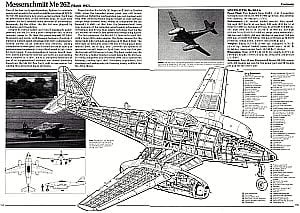Messerschmitt Me 262 Schwalbe History
When the Messerschmitt Me 262 entered service during the autumn of 1944, it was the first turbojet aircraft to do so and thereby opened a new era in aerial warfare. Allied leaders, already anxious about the newly-operational Me 163B rocket interceptor, became further alarmed at the latest threat to their bomber streams and the only immediate, albeit, inadequate, answer to the problem was to rush out the hybrid Republic P-47M Thunderbolt escort fighter. Although this piston-engined aircraft was specially prepared to achieve a maximum level of speed of about 755 km/h (470 mph), it was still some 113 km/h (70 mph) slower than the best level speed of the Me 262 fighter, and other factors, such as better manoeuvrability, could not always make up for this deficiency.
Fortunately for the Allies, only a small proportion of the 1,430 Messerschmitt Me 262s manufactured were employed operationally, and their effects were diffused over various rôles, ranging from day and night interception to reconnaissance and bombing, and, although good results could be, and were, obtained in all these rôles, many tactical errors were made, and the final total operational tally was not outstanding. Although Germany’s leaders made many mistakes which resulted in the greatly delayed service introduction of jet aircraft, the first Me 262s were still put into service some six months before the turbojet engines were fully developed.
By early 1941 the three prototypes of the Messerschmitt Me 262 were completed, but no turbojets were available. To gain some idea of the aircraft’s characteristics, it was initially planned do fit two Walter liquid-fuelled rocket motors, but this plan had to be abandoned because units of sufficient thrust were not then ready. In the early summer of 1942, the first pilot-production 109-004A-0 Junkers turbojet engines were ready, and two of these were fitted to the Me 262 V3 (PC-UC). This aircraft made the first all-jet Me 262 flight, on 18th July, 1942, with 840 kg (1,848 lb) static thrust from each engine but was badly damaged in August during a take-off at Leipheim.
Information on the aircraft’s flying performance, especially that regarding maximum speed, is highly variable. Flight reports dated 1 September, 1944, from the Rechlin test centre quote a maximum speed of 740 km/h at ground level and 810 km/h at 9,000 m altitude, using the maximum permissible engine speed at the time of 8,700 rpm, and at a take-off weight of 6,100 kg. The rate of climb was stated as 14.7 m/sec at 2,000 m altitude, and 1.3 m/sec at 12,000 m. Six weeks later, on 18 October, 1944, the same aircraft with new engines was measured at 780 km/h at ground level (40 km/h faster), and 820 km/h at 9,000 m altitude (10 km/h faster).
Whatever the real figures might have been, it is certain that the Messerschmitt Me 262 was the fastest fully developed fighter aircraft of the Second World War.
Messerschmitt Me 262 Schwalbe Specifications
| Aircraft Type: |
| fighter, light bomber airplane |
| Dimensions: |
| wingspan: 40 ft, 11 in |
| length: 34 ft, 9 in |
| height: 12 ft, 7 in |
| Weights: |
| empty: 8,378 lb |
| gross: 14,110 lb |
| Power plant: |
| 2 × 1,984 lb thrust Junkers Jumo 004B turbojet engines |
| Performance: |
| maximum speed: 540 mph |
| ceiling: 37,565 ft |
| maximum range: 652 mi |
| Armament: |
| 4 × 30 mm calibre cannons |
| Operational Use: |
| 1944–1945 |





